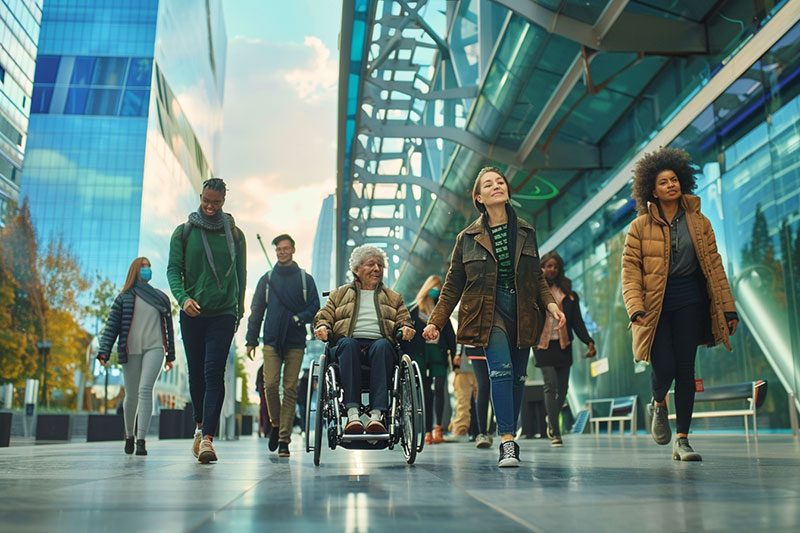Why Smart Cities Are Good News for Disabled Citizens
Smart cities are a concept that always seemed to lie somewhere over the next technological horizon. However, with the advancement of AI, the Internet of Things (IoT) and cloud computing it seems that the age of smart cities is finally upon us.
This is good news for all citizens, especially for those with disabilities. Historically, urban environments have posed numerous challenges for disabled individuals, ranging from navigational difficulties to inaccessible public services. Now, the possibilities seem endless.
With an emphasis on technology and inclusivity, smart cities are beginning to rise to the challenges facing disabled individuals. From safety to transportation, lets look at why smart cities are good news for disabled citizens.

What are Smart Cities?
The term "smart city" is fairly generic. But a simple definition would be: Smart cities harness cutting-edge technologies to enhance urban living, making cities more efficient, sustainable and livable.
In effect, the twin pillars of data and technology allow city planners to incorporate schemes that improve transport, public services, safety and reduce energy consumption. All these factors contribute to a better quality of life. This approach is particularly transformative, as it can help to promote independence for disabled citizens.
Key components of smart cities include:
- Advanced connectivity: Utilizing high-speed internet and IoT devices to facilitate seamless communication and data exchange.
- Intelligent transportation systems: Implementing smart traffic lights and adaptive public transport for easier, more accessible commuting.
- Enhanced accessibility features: Incorporating technology like voice-activated systems and navigational aids to assist those with mobility and sensory disabilities.
- Smart energy management: Using sensors and AI to optimize energy consumption, reducing costs and environmental impact.
- Data-driven public services: Leveraging data analytics to tailor services to the diverse needs of urban populations, including disabled individuals.
The incorporation of such technologies in urban environments can help bridge the gap between the challenges of city living and the capabilities of disabled citizens.
Benefits of Smart Cities for Disabled Citizens
Ultimately, the goal of smart cities is to improve the quality of living for all citizens. But the good news is that disabled citizens can benefit hugely from the way smart cities are redefining just what constitutes "accessibility."

The evolution of urban living through smart city initiatives is closely aligned with the adoption of similar technologies seen in smart offices. These innovations, including smart badge door entry systems, are not only revolutionizing the workplace but are also contributing to the broader reimagination of urban accessibility.
Advanced Connectivity
The advent of IoT devices and the availability of high-speed internet has allowed for unprecedented levels of connectivity. It is this feature that has been one of the great "enablers" of smart cities. In terms of disabled citizens, the benefits that this connectivity brings include:
- Real-time information: Easy access to real-time data helps in planning day-to-day activities, especially for those with mobility challenges.
- Remote access to services: Enables disabled individuals to access various city services remotely, reducing the need for physical travel.
- Enhanced communication: Improved connectivity facilitates better communication with city officials and service providers, ensuring that the needs of disabled citizens are heard and addressed.

Intelligent Transportation Systems
Smart cities are revolutionizing transportation, making it more accessible and efficient. Although there are tips and tricks to effective disability travel, the advent of intelligent transportation systems is helping to level the playing field.
- Adaptive public transport: Smart cities implement systems that make public transport more accessible, such as buses with automatic ramps and real-time route information.
- Improved traffic management: Technologies like smart traffic lights and sensors help in reducing congestion, making travel smoother and more predictable.
- Accessible navigation: GPS and other navigational aids are integrated into city infrastructure, assisting those with visual or cognitive disabilities in moving around the city with greater ease.
Enhanced Accessibility Features
In smart cities, technology is deployed to make public spaces and services more accessible to everyone, including those with disabilities. These enhancements are crucial in creating an inclusive urban environment.
- Navigational aids: Technologies like tactile paving and audio signals at pedestrian crossings assist visually impaired individuals in navigating city streets safely.
- Voice-activated systems: These systems enable people with mobility or dexterity challenges to interact with various devices and services hands-free.
- Customizable public interfaces: Digital kiosks and information screens with adjustable settings (like text size and contrast) cater to a wide range of sensory and cognitive abilities.

Smart Energy Management
The imperative to reduce energy consumption is essential not just for urban living but for the future of the entire planet. However, another upside of such technology is the benefits for disabled citizens who rely on consistent and accessible city services, such as:
- Reliable infrastructure: Stable energy supply is crucial for powering essential services and assistive technologies that many disabled individuals depend on.
- Efficient public facilities: Automated lighting and climate control in public spaces not only save energy but also create a more comfortable environment for everyone.
- Emergency energy management: Smart systems ensure that in the event of power outages, critical services like elevators and emergency lighting in public buildings remain operational.
Smart Cities: Building a More Accessible Future
The age of the smart city has had several false dawns. However, the technology barriers have been lifted and the true dawn of the smart city is upon us. Disabled citizens are unlikely to have their lives transformed overnight, but the changes are happening and the benefits are already becoming apparent.
With the technology in place and the momentum gathering, disabled citizens can look forward to a more accessible and inclusive smart city-powered future.
Pre-Register for Abilities Expo Today...It's Free!